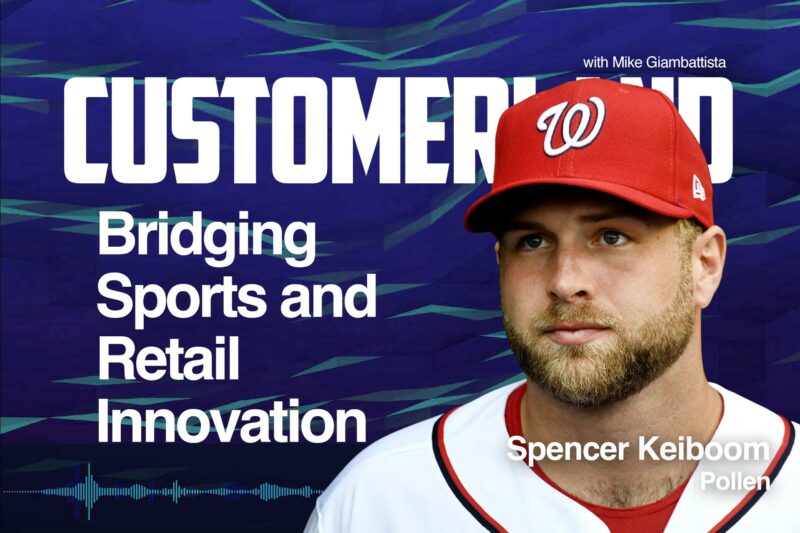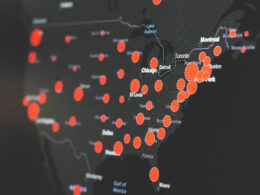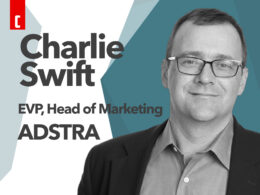Hear how Pollen is revolutionizing the retail industry by integrating technology to create efficiencies among existing middle-mile companies.
Have you ever been intrigued by the resilience of athletes and wondered how that could be applied in business? Spencer Kaiboom, the founder and CEO of Pollen, joins us to share his fascinating journey from making it to the baseball major leagues to becoming an entrepreneur. Spencer gives us an insider’s view into his life on the field, the extraordinary people who influenced him, and the lessons he learned from his baseball career that now drive his business.
Switching gears, we dive deep into the inner workings of Pollen, the innovative company Spencer built after hanging up his baseball cleats. He enlightens us on how Pollen is revolutionizing the retail industry by integrating technology to create efficiencies among existing middle-mile companies.
In the final leg of our conversation, Spencer uncovers how Pollen addresses the long-standing problem of return shipping costs that has been a thorn in the side for many retailers. Leveraging the existing rideshare ecosystem, Pollen offers competitively priced return pickups, helping brands reduce abandonment rates and maximize their profits. This episode is a must-listen for all those interested in the exciting fusion of sports, entrepreneurship, and technological innovation.
Full transcript below
Mike Giambattista
This is kind of a different episode of customer land for people who listen regularly. What makes it different is the person we’re talking to. He is a founder and CEO of a really, really interesting company. That we’ll hear more about in the second half of the conversation, but the first half of the conversation is what I think makes this so interesting, unique, different.
Spencer Kaiboom, who founded this, came to it through a long, circuitous, interesting and really tough route and I think, for entrepreneurs especially, you’re going to get something out of this that elevates the conversation beyond just the mechanics of what it takes to start an interesting company, but maybe even more so what it takes to overcome the enormous obstacles and inertia involved in doing so. I hope you get as much out of this conversation as I did. Wanted to kind of reconvene on a conversation we had a while back on what pollen is, because I don’t think I did a great job of that and it’s a truly innovative solution. But before we even get to that, I want to talk about Spencer’s background a little bit, because it’s unique, especially in the startup world. This just look, I don’t know anybody who’s got your background. Frankly, so real quick, spencer, if you would tell us where you came from, and then what? From that to this?
Spencer Kaiboom
Yeah, so my background is in professional sports, specifically baseball. I went to Clemson, left after my junior year, played eight and a half years professional baseball, found myself in the minor leagues for pretty much my whole career but played parts of three seasons in the major leagues, got about a little over a year of service time in major leagues, caught my whole life, lived in dairy farms in upstate New York in the base beds of people’s homes, which is it’s funny, but it’s also it’s incredible to people that you meet along the journey that are willing to open their doors to give you an opportunity, and that’s something that a lot of guys don’t, we don’t talk about, but it’s something I mean. I invite these folks to my wedding, right. I mean, at the end of the day, I mean that’s how close you get with them because of how much of an impact they have. But played pretty much at every level that you can imagine in the minor leagues. Somehow spent my whole career with the same team, with the Washington Nationals, but that’s the way it drew up 2016,. Probably one of the worst seasons of my life, but it was the first season that I was put on the roster. Okay, double A came in a great shape but at the same time found myself probably more actually I’ll probably, I know for a fact more worried about what everybody else was thinking, rather than being who I was and what got me there, which really put me behind. You know, the eight ball my back against was against the wall.
And after that season I didn’t get called up as a September call-up, which I was one of, I think, two people who were not. I went home that off to Atlanta since the earliest I was ever home because I always did like a fall league or whatever it was. And so end of August, early September, I go home and normally, like a lot of guys, take three to five weeks off pretty much after I mean it’s a lot of games I mean minor leagues is still 142 games and I went straight to working out. I mean I went straight to it to fix, probably work through more some stuff mentally than anything else, but still went straight to it. And I remember being at home and getting a call and they were like Wilson Ramos, who was the catcher at the time, actually tours ACL, and they’re like, hey, you need to be in DC tomorrow. And so I’m like, oh Sweet, I mean now here we go right, and so I’m up there for the end of the season for a week and Dusty Baker was the manager. He actually was kind enough to give me one at that I can’t remember the person’s name, but he was on the Marlins but he was truly throwing 98 to like 102. And I hadn’t seen pitching now in about four weeks.
And it was funny. I walked and my dad I think my dad, my parents were there and so was my wife and my dad’s like that was a great eye on my thing. Like I didn’t see shit out of that guy. He’s throwing so damn hard. But thanks, you know, I don’t. I didn’t swim back, I just knew if I had two strikes. I was like I got a swing, I mean, I it just you know. But I went home after that and I didn’t even count it in my own head. It was.
It was something where I knew what had transpired in 2016. I knew why I was there. It was you know, unfortunate events can be somebody else’s, you know, triumph, and that’s essentially what happened. But I didn’t consider it a triumph. Making it to the major leagues was not like just the dream. There was more to it than that I wanted to set goals inside of that dream 2017, they took me off the roster in spring training, told me I’m playing for 29 other teams and they didn’t view me as a big leaguer with the Washington Nationals, which was a pretty rough conversation in an office with four people, and, the flash forward to the end of the year, I’m in AAA and I’m playing every day again. I hit over 300.
That season, threw out a bunch of runners, had an awesome year, and the season ended with a foul tip that broke my the top of my foot one of the small bones at the top of my foot with like two days left. So I was not called up. I wasn’t on the roster. I thought I would get. It’s called rule five, where they can, somebody can grab you from another team and put you on the roster. That didn’t happen either, and so I show up spring training in 2018 and I’m still gun hoe and I mean I’m ready to go I know what I did the year before and break with the team in AAA I was there till the last day, though, with the big league team and go to AAA, and four weeks later, I get a phone call and I’m flying to Arizona and they put me on the roster and stayed up there the rest of the season in 2018. Never went back down Now, granted what’s happened and led up to this point, which 2019, was my last year in 2017, so go back to where we’re coming in.
I actually had an unfortunate accident happen where somebody put something in my ear that should not have gone in my ear. It was actually a medical procedure and I lost my hearing in my right ear, and so I had a bunch of balance issues going into 2017. And so I’ve always found that self-pity is one of the most disgusting things, and I just kept going, and I’m so glad I did, but I didn’t realize, actually, how much hearing impacts where the ball goes off the bat, because that’s your, to call it, your second set of eyes, so to speak, especially when you’ve been doing it for so long. And so push forward and head to the 2019 season, and it was a disappointment, but what I had realized was there’s still more to it.
It just I was hoping to get out of the organization, really truth be told, and after the 2019 season, I go to my annual ENT appointment because of what had happened, and they’re telling me I need to go see a neurologist and they said I have something called the Celestia Toma in my right ear, and the Celestia Toma for anybody who is listening is a. It’s called a benign tumor and so it’s not something where you go. Okay, this is cancer, but they apparently grow at rapid rates and they don’t know if it’s gonna grow fast or slow. They didn’t have no idea and so I told the neurologist I was like, well, cool, I’ll probably see in six months, because I had been taken off the roster again and I had opportunities to go play with like the Red Sox and some other teams maybe Indians, I can’t remember.
But basically I go see in six months, she goes, and I’ll see you in like more like four weeks, to like monitor this every four weeks, and I’m going, holy shit, like this is serious stuff. And so I ended up getting a surgery within six to eight weeks after that and I had to get a follow-up surgery again which really took me out of the whole year, the whole season, and essentially, at 29 years old, you really can’t take a year off in the position that I was in and the inclination of going back to double A, to be a backup and to do something like that and to maybe get a call up again is that’s a tough path and a pill that I just couldn’t swallow, and especially with, even today, having still some balance issues from stuff going on. But it doesn’t impact my life from a business perspective, so to speak.
Mike Giambattista
Oh, sorry, so what happened then? So, because there was a transition, that happened and like you know.
Spencer Kaiboom
So the surgeries, yeah. So I found myself playing in bed with no idea what to do. I signed up for classes at Clemson. I had 32 hours left. My joke is it took me longer than Van Wilder to get my undergrad degree. It took me 11 years but we got it done. And I found myself sitting at a Kohl’s making a return for an Amazon return. And I had an idea in college, which is technically pollen today, how it’s evolved.
And I found myself at this Kohl’s for four or five months straight. I mean, I’m there pretty much every day Inside the store tracking people, watching buy rates, looking at how they figured out the pricing and why they’re doing like what’s going on? Where is this product going? Actually, visited one of their main hubs down in Macon, Georgia. I was nice they were nice enough to let me go down there when I met some big Rams on and then spent a couple of weeks between UPS and FedEx figuring out their pricing and how things work there, and then even spent time at Ace Hardware and at Dick’s Sporting Goods looking at RFID how does this work, separate from vendors who come in and sell, like at Ace Hardware, you name it and the funny thing was they all let me. They shared everything, because I said I was in college and writing a paper, but they didn’t ask what it was on. I think they thought it was a masters or something, although it was an undergrad and I was 30, which was funny. But they were sharing everything with me and I’m going. There’s so much value here.
And at that moment in time, that summer in 2020, I met a gentleman named Mark Hart, who’s a co-founder, who is our COO, and Mark had 30 years in supply chain. Mark, seven years of target XPO, GXO, did warehousing inbound, outbound, stood up tens of millions of square footage and understood re-tagging and he’s like I know exactly what this does to the warehouse. This is a game changer and understood how all that worked and I’m like sweet, didn’t know what a cap table was, didn’t know any of that, and didn’t know what a safe note was. I thought it sounded just safe, so, but I ended up raising a half million on a safe note. Didn’t know how to communicate with a technologist or dev team, but I did know that I love design aspects to things, so I started watching tutorials on Adobe XD and would just build wireframes to send over to them, just to maximize the dollars and create working product that I was like. I can’t tell you how to make this verbally at this moment in time, but I can show you what I’m thinking.
Mike Giambattista
So from there? So at some point in the saga of your baseball career, you reactivated. What became pollen. Was that after things, after kind of like, you decided, I can’t go back, or was that kind of happening simultaneously?
Spencer Kaiboom
It’s when I realized I couldn’t go back and I’m going. I don’t know what I’m gonna do, and that, for me, was when I’m going. Okay, if something again unfortunate, or whatever it is. I think some kind of suffering always makes you stronger at the end of the day, and when I make a decision, I don’t dwell on the past. I just try to really draw from my experiences on the past in order to either make more informed decisions, better decisions, smarter decisions, whatever it might be, whatever lesson you pull from it and the game of baseball itself, from what it taught me, is just it’s incredible. I actually wish more guys were able to pull their experiences and apply them to the real world, outside of just being a baseball player.
Mike Giambattista
Well, I think that would be an amazing follow-up conversation just to take those lessons and how they’re applied, how you’re applying them to pollen outside of that, because there’ll be a lot of people who would find that just really interesting and enlightening and probably really helpful.
Spencer Kaiboom
Yeah, I would love to, I mean. But in short, for me, especially from a catching position, looking at data was something that is extremely applicable. Being on teams my whole life, I joke, but I’m also serious. I can’t play center field, I’m a catcher. That was my position right. So bringing Mark on board the first step was a big piece to the puzzle. He’s filling a position and need that I know I can’t perform at and I don’t have the experience at or the reps at. And then having my ear to the floor, we did an accelerator out of New York City called Entrepreneur Roundtable Association, which I would highly recommend to anybody, especially as a first-time entrepreneur. I met our CTO. He was the 10-year technical resident and I mean he’d seen hundreds of companies come through. I mean we built just a phenomenal relationship and he’s like I want to do this full-time with you and I’m like awesome, I would love nothing more than this. And then he joined us full-time Left. We’re the first company he’s done this with full-time out of there.
It was in the last 10 years and then running an MVP, simultaneously doing integrations with some folks without naming their names that were large to where? Then you just kind of get like the halt. I mean, we had one company say well, what if we just buy you instead? And you’re going? What if we just run these pilots instead?
And then next to I do a pitch competition, for example, and I meet Christian here, and Christian was one of the judges at a center tower and we were called practicing the day before and the next day you’d actually do the pitches and whatnot. But I heard Christian say something and I’m like I think this is the smartest person in the room and it was somewhat, unfortunately, overlooked as to what he said. And after that I was like I just want to stay in touch with this guy and, to make the long story short, there he was introducing to people that he felt that I should hire, asked me hey, why haven’t you hired these folks? And I’m going well, I don’t want to dance with them, I want to dance with you. And so next, you know, Christian’s on board and filled another hole that we really needed.
Mike Giambattista
Phil. So that’s a great transition, because I want to hear Christian’s story too. Don’t know if there’s baseball in the background or whatever it is, but you know first what was the thing before even get to that. What was the thing that Christian said that you were like wait a second. I got to pay attention here.
Spencer Kaiboom
Somebody had pitched about it with one of their middle mile companies and, like a middle mile, just one of the hundreds of middle mile companies out there, same kind of concept and idea Christian asked them. You know, are you guys? Is your technology laying over the existing you know existing middle mile companies to create efficiencies among them? Because a lot of supply chain inefficiencies are due to too many software solutions and too many individual apps. And I’m thinking in my head well, he’s going to love what we’re doing because we lay on top of everything that’s there too. But I’m going that’s so true, right? I mean, everybody’s got different systems, everybody’s running different software, everybody’s running all these different solutions and yeah, of course you can do integrations, but at the same time, I mean uncle, right At the end of the day, and if you can lay over what’s already existent to create a more harmonized process, they are creating new efficiencies in what’s already existing.
A message from today’s Sponsor
What could you achieve if you knew what your customers expected ahead of time? What if you could know what customers expect by category and by brand, 12 to 18 months ahead of traditional brand tracking methods? And what if you could know exactly where to adjust and where to spend in order to drive the most benefit? Every time.
A customer expectation audit allows you to identify areas that require strategic reinforcement, as well as pinpoint which values will contribute most to an emotional bond with your brand and optimize accordingly. Customerland has partnered with Brand Keys, the world’s oldest loyalty-focused consumer research firm, to bring real-world customer expectation audits to brands, brand managers and to CX. Practitioners. Everywhere Want to know where your brand stands and exactly what to do about it. Go to expectationaudit.com and download a sample audit today.
Mike Giambattista
Today, as I’ve come to understand the mechanics of what pollen does, there are a couple of things that stood out to me as and I want to ask you before I just start calling this stuff out but you know, the idea that you’re using the existing delivery services and finding unused, basically asset time and deploying on behalf of returns seems like. First of all, it’s genius If I’ve really framed that up correctly. And and why hasn’t anybody thought of this before? Because it’s it’s, it’s so available if you can figure out how to harness it. So, first thing, let me just let me just ask you did I even be there and come close to framing up the property?
Spencer Kaiboom
Yeah, I know, you know you did a great yeah. No, you framed it up phenomenal Well. Picking up returns is not a novel idea. I think we just have this, this concept in our head that will. It’s not really kind of just a fact like no transportation manager is going to sign off on paying $5 for the pickup and $8 for their shipping label combined to increase their return shipping costs, you know, 50% plus. Essentially it’s not going to happen.
And that was the really big piece to this is like a pollen is the how. At first, because you have to make it call, it call, you know, cost competitive, right? I mean, at the end of the day it’s got to be. If it’s not the same price, it’s got to be damn close or just a tick less. But that’s because that’s something where that’s just the industry itself. That’s how we, everyone views this. Is it’s return. I don’t want to be paying more money for it. Even if you show me a massive ROI in efficiencies, that’s still not going to come till down the road. So immediate benefits have to be something that somebody can tie. You know, hold on to selling more goods and I’m not paying more money for my returns and return shipping.
And so that was the big piece of the how, and that was something that you know evolved as well, because the thesis when I started was I’m going to pick it up and I thought and the thesis was it’s not about building a new rideshare army or a new arm and new app on the app store for somebody to download to get more pickups, because again, now we’re going to more apps and more software, which makes it even more confusing, especially for these drivers, and I provide to the existing rideshare ecosystem and their platforms that truly works in conjunction with their current offerings between people and food.
And it just so happens that there is a lot of downtime and there is even ways to even to optimize where these drivers make drop offs, to maximize their inbound deliveries again from where they came from. Right, I mean, that’s something where we’ve even had some great discussions with folks like, hey, what if we make your drop offs within a mile to half mile radius of one of the 80 grocery stores that you deliver for? That would be really nice, right? What if it was at 1130 in the afternoon and five o’clock in the afternoon where all the restaurants are? So that’s possibilities and things that we have the capabilities to do and to bring those new efficiencies to them, to where now rideshare doesn’t have to over incentivize their drivers to keep them on their platform. There’s nothing better than knowing the night before some driver claims 10 pickups for 50 bucks within a three mile radius that hey, I have this driver locked in from 81030. Now, right, I know they’re going to be dropping this off over here.
Mike Giambattista
So, you’re, you’re leveraging rideshare downtime effectively, right, specifically the delivery services. I kind of just want to let that hang in the air for a minute, because it’s so damn innovative and it’s such a great use of an asset just waiting there to be leveraged, and nobody did so. Let’s talk a little bit about, if you would, about how this has been received by the retail world. I know you’re a very fresh company. I think that you know I’m editorializing badly here, but I think that understanding the proposition, so you know people have to go off, it has to go off and go wow, this is, this is valuable, this could actually mean genuine dollars to the company. But you have to get it and you have to believe it because it’s, it’s honestly, it’s like is this too good to be true, does actually work, so? So what’s that process like when you’re talking to somebody?
Spencer Kaiboom
It’s evolved because you know, you had a lot of folks during COVID playing catch up to their competition for same day and next day delivery, to even pushing their apps to consumers, to curbside pickup you know all of those, those three things that I just mentioned. Those were, those were cart conversion nuggets for everybody. What was happening was the folks who had them in play even before, you know, before COVID, although maybe unbeknownst to me, the consumer. We’re now turning over every stone as a consumer to find these conveniences, which is a way for them to reduce the abandonment rates. And now again, what’s? What’s occurred, for example, is okay, everybody’s offering this stuff now. And those abandonment rates, although you had the edge for a little bit, I’ve now crept, you know, crept back to maybe where they were, you know, pre pandemic. And when you look at returns, it’s the last you know. To me, it closes the loop of the buying experience. Even if the consumer is not making a return necessarily, they just they know they have a sense of comfort, it’s ease, they want to know what it is being forward with, whatever that might be.
And something that I always I love, that I studied very closely and dove in heavily on was, for example, what Zappos did in 2003. This is 20 years ago. Zappos offered free returns mind boggling right 20 years ago. And what Zappos began, what Zappos accomplished after offering free returns, was they tripled their revenues for three years straight. They did an 85% increase and repeat customers and their marketing budget dropped below 3% into their margin. And there’s a lot of other benefits, but those are just some good high level you know nuggets and. But at the same time, that was a policy.
And, by the way, when Zappos tripled the revenues, they only sold a billion dollars. Now we have companies selling eight, 10, 15, 20 billion dollars plus online. And yeah, their return rates were in the 20% range, like everybody else is now, because they offered free returns, but that was the only thing they could do at the time and the volume that was going out never really warranted necessarily some kind of solution. But when I look at Paul and I go, you couldn’t monetize that as a business free returns but what you can monetize is an experience to the consumer with a domino effect of benefits that are created to the retailer by creating these product deficiencies of their returned existing product. And that’s exactly how I view us is. We are monetizing essentially what Zappos did in 2003 with a free return. If you feel comfortable saying which I know, Christian and I do, and a lot of other folks that return pickups are the next evolution of what a convenient return policy would be we’ll have in play.
Mike Giambattista
I actually think it goes beyond that. I think it contributes to long-term customer loyalty.
Yeah, because the whole experience has been kind of smoothened out. So I was looking over your site and you use this phrase a couple of times and I’m just hoping to get it unpacked a little bit. I’ll read this Paul and his first return solution to complement today’s retail delivery channels that provides retailers with a revenue lever of controlling when goods are coming back. And there’s a lot in that little word lever, you know that’s I mean it’s packed with value. But I want you if you would unpack what that would mean for a retailer. What does that really mean?
Spencer Kaiboom
I mean returns. Right now they look at them as a cost center and we look at it and say we’ll put a line through cost and they’re a new profit center for you. And because of fraud, it was 10.4% last, for example, last quarter. Okay, we’ve required a no box or label, right, so now you can actually see the good, you’re actually know what you’re picking up, so you mitigate fraud right off the bat. Right On the other side of this, too, is the amount of data that we’re getting, where they can essentially control when these goods are coming back. How fast these goods come back is a way for them to leverage that existing product.
Another mind blowing statistic, too, is yes, there’s a lot of returns out there. Yes, they cost hundreds of billions of dollars. But we look at returns as a consumer in our head and we think like, oh, this is like it’s faulty product or whatever you know, it’s dirty goods almost. But what’s crazy is the grade returns grade A, grade B and grade C. Grade A means I could get it back if it’s a store and I bought it from the store and I could put it right back on the shelf Like that’s grade A, right, the box is not open. You name it right. It’s got the tags on it. There you go, it’s hanging back up, it’s there. Over 80% of these goods are coming back as grade A.
Mike Giambattista
That’s a wild statistic.
Spencer Kaiboom
Over 80%, but what’s actually being utilized as grade A is less than 30% of that. And so why is that the case? Why is that the case? It’s time and I always like to use a simple example is. I mean, imagine you’re going on a vacation with your family for Labor Day weekend and maybe you, or your spouse, or whomever, buys you a couple of bathing suits to try out. You’re going to the beach and it’s April 15th. Well, September 10th rolls around, labor Day’s gone and you decide to return two of those three bathing suits. What do they do with them now in September? Right, they’re gone. Right, they have to essentially liquidate it, or you know, whatever their dispositions may be. And so, by getting goods back faster, as Christian alluded to earlier, fast out needs fast back, and if you can do that now, you create an insane amount of inefficiencies that even trickle all the way down into the future of even making better predictions as to how much inventory you truly need on hand because of what you’re going to be able to leverage with what’s coming back.
Mike Giambattista
So I alluded to this a little early in a conversation, but Pollen’s a fairly fresh company. It’s been a development for quite a while apparently, but you know fairly new to the market. You mentioned that you had run test cases with some fairly sizable retailers. Are you at Liberty talk about any of the current clients you’re working with right now? I know a lot of brands and retailers out there probably aren’t too cool about letting you peek behind the curtain operationally, but are there any brands that our listeners might know that are that are deploying your solution?
Spencer Kaiboom
Yeah, so we ran with call it some we would consider small to mid tier, maybe almost mid in the MVP stages.
We’ve even done some stuff with some medical device companies and dabbling over there, and for us right now our main focus is we have phenomenal data and what we’re what Christian eyes main focus is finding that right brand or retailer that is recognizable, and we right now have a good call it handful of them that are gearing up for pilots for this year, and our main focus is is measuring the. What are we doing to your abandonment rates? What are we doing, for example, to your LTV, your customer acquisition costs? What are we doing to your shopping cart minimums? You know, what are we doing to incentivize app downloads, membership signups, you name it, because that’s the instant benefit that you can get somebody by saying, yep, we have returns picked up, we’re running pollen boom. Here we go. This is the numbers that we can expect and we want to. We want to have the right brand or retailer with, you know, with that data, and we believe that will be extremely powerful to where then we say, great, now we can go at hyperspeed with that.
Mike Giambattista
Do you have? I mean, what’s, what’s the profile of your ideal pilot right now, your ideal customer, your ideal client?
Spencer Kaiboom
Yeah, so fashion, apparel, electronics, I mean even trade in programs. We can do health care as well, like some testing kits. There’s obviously some stipulations as to what you can pick up from a hazardous perspective, but there’s very few things that you can’t. But somebody who’s looking at it and, let’s say, as increased their direct to consumer approach if they were a retailer like a omnichannel brand with stores and whatnot, but they’ve increased their direct to consumer approach. Or they’re a retailer who has multiple stores but is also trying to grow their online presence. Somebody who is, let’s say, struggling with their marketing dollars eating into their margin. Somebody who’s had excess inventory over the last year and is continuing to fight these excess woes that we continue to see in headlines those type of folks for us, are the ideal customer profile.
Mike Giambattista
Would you say there’s any particular vertical within that description? That’s kind of the sweet spot.
Spencer Kaiboom
In regards to like the type of products that they sell.
Mike Giambattista
Yeah, I mean, would it be fashion retailers? Would it be your, you know?
Spencer Kaiboom
Yeah, fashion retailers, your electronic companies, that we can all think of those type of folks. Right, there are our prime examples. I mean, for example, you can go okay, electronics like let’s just and, by the way, I’m not soliciting or saying we’re talking to these folks when we’re actually not. But Apple, for example, they have computers, right, they have cell phones. People buy them directly through them. What can we do to your abandonment rates? What can we do to your purchase conversions? What can we do to signups, memberships, loyalty? What can we then do to recovery rates? Because you know, trade in recovery is pretty much less than 50% success from online purchases and having those goods traded. So how much can we increase that? For up to 95%, 98%, so they’re getting more value back for anything that’s being traded in and being offering a discount, or Apple bucks, whatever that might look like. That’s a great example. Retail, Same concept. Obviously not trade ins, but how can we even incentivize exchanges for you? At the end of the day, retain those dollars, so it’s really worth it.














